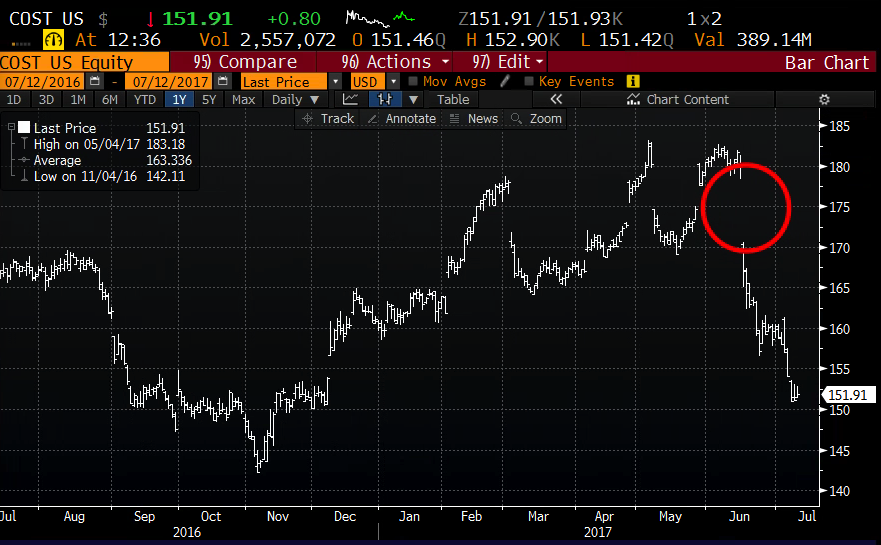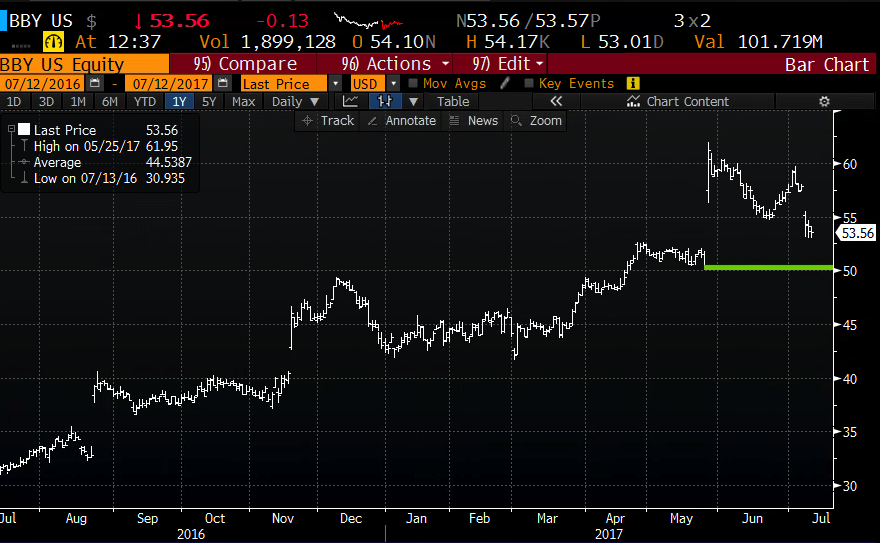On Monday morning shares of Best Buy (BBY) gapped down 5% and closed the day down 6.4% on news reports that Amazon.com (AMZN) has launched a service to compete to set up gadgets at home, an obvious threat to Best Buy’s Geek Squad, per Recode:
The new offering, which has already rolled out in seven markets without much fanfare, is aimed at helping customers set up a “smart home” — the industry term used to describe household systems like heating and lighting that can be controlled via apps, and increasingly by voice.
While Amazon has a marketplace for third parties to offer home services like TV mounting and plumbing, these new smart-home-related services seem important enough to Amazon that it is hiring its own in-house experts. And perhaps for good reason.
Smart-home gadgets make up one of the fastest-growing segments of the consumer electronics industry, but they can be difficult to set up and integrate with each other. That hurdle has led to higher-than-normal return rates, experts say, so Amazon is likely looking at the in-home services as one way to lower that number.
Despite this week’s decline, shares of BBY remain higher on the year by about 25%, but are down nearly 15% from its recent 52 week and all time high made in late May following a better than expected fiscal Q1 earnings report that caused the stock to explode 21% the day after the print on strong digital sales, up 22% year over year.
For years, ever since AMZN made bookstores go the way of the dodo, and it appeared there was little room for more than one national bricks and mortars consumer electronics retailers (Circuit City shuttered most of its stores in 2008/09 and Radioshack is nearly done this year), investors have been calling the end of BBY.
Ironically, AMZN’s $14 billion bid for The Whole Foods Market (WFM) last month might have solidified the case why certain high-end retail (like electronics) with fat margins still have a place within store fronts, especially if they were to find the proper e-commerce partner like it appears WFM has done. BBY has about 1100 electronics stores and about 350 standalone mobile phone stores might prove useful to an e-tailer looking to go the other way, as AMZN has done with their omnichannel approach.
For those looking for a decent entry on the long side on BBY you might want to first consider the continued weakness of Costco (COST) since AMZN’s WFM bid…

There might be more to go in BBY shares’ latest pullback, with a realistic near-term downside target of $50, which would be a gap fill from the day prior to earnings in May:

BBY is a cheap stock trading at a tad less than 14x fiscal 2018 eps estimates that are expected to be up 9% yoy on 3% sales growth. The company has a stellar balance sheet with $2.25 billion in net cash, or about 14% of their $16.3 billion market cap, sporting a 2.55% dividend yield. Oh, and despite the stock’s outperformance to the sector and the broad market in 2017, sentiment remains poor in the name with nearly 15% of the float sold short, and the Wall Street analyst community is less than sanguine with only 8 Buy ratings, 16 Holds and 3 Sells.
AMZN is clearly crushing BBY in the current environment, and most retailers are feeling AMZN’s pinch. But I also suspect we end in a new environment where some bricks and mortars retailers like BBY (with a $40 billion revenue base) find they can coexist in AMZN’s world (even as they begin to encroach on services like Geek Squad) especially if they team up on creative omnichannel approaches like we’re about to see from WFM and AMZN.
The next identifiable catalyst for BBY will be their fiscal Q2 results on August 29th. The lower the stock goes prior, the more attractive a long entry might be, especially if the stocks recent weakness sees it near $50.
In the meantime, those looking for a long entry would be wise to minimize premium at risk over the Summer, with the Sept catalyst a ways away.
Bullish
BBY (53.65) Buy the July/Sept 55 call calendar for 2.25
- Sell 1 July 55 call at .40
- Buy 1 Sept 55 call for 2.65
Rationale – This trade works best of the stock is at or near 55 on July expiration (in 9 days). The ideal situation after that is to then roll the short leg of the calendar to August, and then eventually creating a very cheap Sept call or call spread once those expire as well. These calendars take some patience and trade management but they can be well worth the effort to avoid decay while looking out a few months for a move higher.